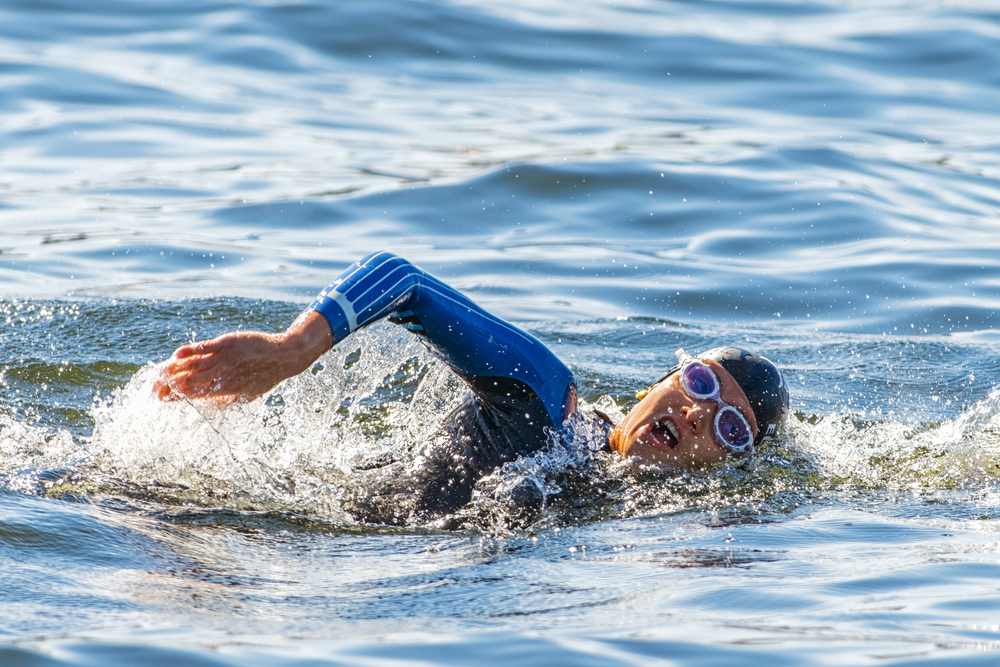When it comes to swimming in a triathlon, you can choose the stroke that you swim in! Some parameters are set around the stroke used, but ultimately the choice is down to the swimmer!
You can choose between backstroke, breaststroke, freestyle, and butterfly when swimming in your triathlon. Each stroke has guidelines that you will need to follow when taking part in the competition. It’s worth checking these with the organizer of your triathlon.
Sometimes, these can differ from event to event and can be based on the level of the competition (i.e., beginner, intermediate, etc.).
Brush up on the guidelines of the strokes used before the competition, as you can be disqualified if you are not swimming correctly! It’s best to know the guidelines while training, too, so you can get into the rhythm of swimming this way.
When selecting the stroke to swim in, it’s worth noting that you aren’t tied to this. Swimmers are free to change strokes as preferred when swimming, providing they still meet the guidelines.
We often see swimmers start in front crawl (freestyle), as it’s the fastest and most efficient stroke before transitioning into other strokes as the swim progresses. Swimmers are also free to tread water, providing their technique matches the competition’s guidelines.
You can usually find these guidelines on the competition’s website or in any correspondence they have sent you. If there are specific guidelines in place, these should be made clear to all competitors well before the triathlon commences.

Do you have to swim freestyle in a triathlon?
While many swimmers opt to, you don’t have to swim freestyle in a triathlon. Freestyle, or front crawl, is often the preferred stroke for swimmers to use as it's the fastest and most efficient stroke out of the ones you can swim in a triathlon.
Freestyle will allow swimmers to propel through the water quickly, giving them the speed they need to finish the swimming portion of the triathlon.
Although it's the fastest stroke, and you will need to be reasonably quick when completing a triathlon, speed isn’t everything. You will need to save your strength for the bike and run part of the race, which is why people opt for freestyle stroke over breaststroke in a race.
The choice is entirely yours to make, and we recommend experimenting with strokes when training to find the one that best suits you and allows you to complete the whole race; remember, the swim is just one part of the triathlon!
If you are going to use freestyle in a triathlon, then the technique is everything!
As we mentioned before, each race has its guidelines for the swim portion, and it's best to be familiar with these while training. Having the correct technique ensures you don’t get disqualified but can help conserve your energy and avoid any injuries while competing.
No matter the stroke you are using, ensure that your technique is correct! Some triathletes will take adult swimming lessons or consult a swim coach to ensure their technique before completing the race.
If you haven’t swum in a while or are unsure, a swim coach is a good idea. You can usually find coaches in your local area at your pool or by searching online.
How do you do a front crawl triathlon swim?
When using front crawl in a triathlon swim, you will first need to check the competition’s guidelines. You will need to follow specific guidelines to prevent being disqualified, and we recommend checking these during training to master the technique.
Generally speaking, a front crawl in a triathlon works with swimmers lying on their stomachs, using their arms and legs to move through the water.
In a pool, you can push off the wall with your legs, propelling your body into the water. You can use the sand or lower yourself into the water in a lake or sea, so you lie on your stomach.
Move your arms vertically forwards, with your fingers closed together. This prevents water from traveling in the gaps and allows you to move through the water easier.
Using your legs at the same time, kick them up and down. You can bend your knees slightly if this is more comfortable, although typically, swimmers kick with their ankles and keep their legs reasonably straight.
We recommend raising your head and breathing every three arm strokes. You can alternate sides and raise your head slightly to breathe out and inhale before placing your face in the water again.
For those that are returning to swimming or haven’t swum in a while, it's worth consulting a swim coach who can help improve your technique and ensure your form is correct at all times.
Improper form can cause you to tire easily and even cause muscle pain or disqualify you from the race!
Can you swim breaststroke in a triathlon?
Yes, you can swim breaststroke in a triathlon! As we mentioned earlier, swimmers can choose the stroke that suits them best, providing they follow the guidelines set out by the race organizers.
While you can swim breaststroke in a triathlon, many swimmers opt for freestyle as it’s a faster and more efficient stroke that doesn’t require too much work from your leg muscles compared to breaststroke. That being said, you don’t need to rule out breaststroke just yet!
Swimming breaststroke in triathlons has its benefits! The stroke provides swimmers with a “rest” while they still swim!
If you are starting to struggle or feel that you need a break, swapping to breaststroke allows your arms and legs to slow down and gives you time to recover while still moving through the water! It’s a better alternative to treading water where you remain static.
Breaststroke can also be handy when swimmers have gone off course; you can easily navigate back, especially if using modified breaststroke, where your head is out of the water.
You will need to check that this is allowed in your competition, but modified breaststroke provides an easier and more natural sighting that swimmers can be grateful for!
Why not try and incorporate some breaststroke into your training before the triathlon and see how you find it? Remember, you can always switch strokes during your race, and breaststroke can be a handy switch from freestyle if you need to gather your thoughts or realign your breath.
